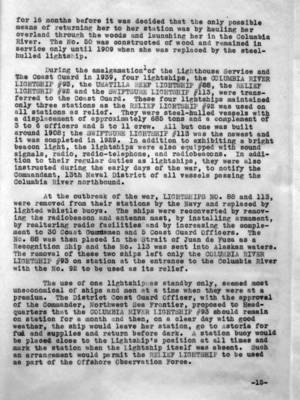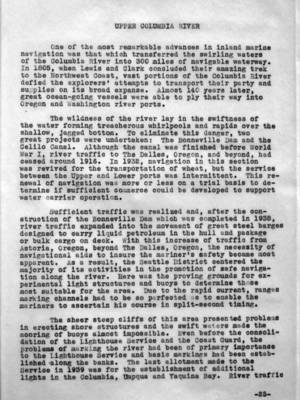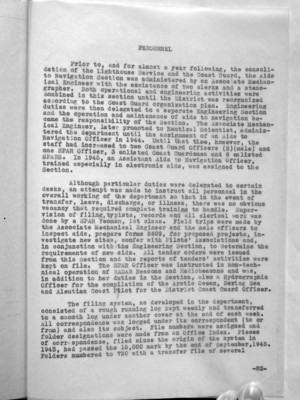Pages That Mention LIGHTHOUSE SERVICE
Coast Guard District narrative histories 1945
34
for 16 months before it was decided that the only possible means of returning her to her station was by hauling her overland through the woods and launching her in the Columbia River. The No. 50 was constructed of wood and remained in service only until 1909 when she was replaced by the steel-hulled lightship.
During the amalgamation of the Lighthouse Service and The Coast Guard in 1939, four lightships, the COLUMBIA RIVER LIGHTSHIP 393, the UMATILLA REEF LIGHTSHIP #88, the RELIEF LIGHTSHIP #92 and the SWIFTSURE LIGHTSHIP #113, were transferred to the Coast Guard. These four lightships maintained only three stations as the RELIEF LIGHTSHIP #92 was used on all stations as relief. They were steel-hulled vessels with a displacement of approximately 685 tones and a complement of 3 to 6 officers and 5 to 11 crew. All but one was built around 1908; the SWIFTSURE LIGHTSHIP #113 was the newest and it was completed in 1929. In addition to exhibiting a bright beacon light, the lightships were also equipped with sound signals, [radio]], radio-telephone, and radiobeacons. In addition to their regular duties as lightships, they were also instructed during the early days of the war, to notify the Commandant, 13th Naval District of all vessels passing the Columbia River northbound.
At the outbreak of the war, LIGHTSHIPS NO. 88 and 113, were removed from their stations by the Navy and replaced by lighted whistle buoys. The ships were reconverted by removing the radiobeacon and antenna mast, by installing armament, by realtering radio facilities and by increasing the complement to 30 Coast Guardsmen and 5 Coast Guard Officers. The No. 88 was then placed in the Strait of Juan de Fuca as a Recognition Ship and the No 113 was sent into Alaskan waters. The removal of these two ships left only the COLUMBIA RIVER LIGHTSHIP #93 on station at the entrance to the Columbia River with the No. 92 to be used as its relief.
The use of one lightship as standby only, seemed most uneconomical of ships and men at a time when they were at a premium. The District Coast Guard Officer, with the approval of the Commander, Northwest Sea Frontier, proposed to Headquarters that the COLUMBIA RIVER LIGHTSHIP #93 should remain on station for a month and then, on a clear day with good weather, the ship would leave her station, go to Astoria for fuel and supplies and return before dark. A station buoy would be placed close to the Lightship's position at all times and mark the station when the Lightship itself was absent. Such an arrangement would permit the RELIEF LIGHTSHIP to be used as part of the Offshore Observation Force.
37
The early conception of the mariners, that all aids to navigation must be received by the normal senses of sight and sound, was radically changed by the development of the radiobeacon system which has, since its inception in 1921, become recognized as a most important innovation for increased safety for mariners. As radio signals are not obscured by fog, wind, rain, snow or temperature changes, and bearings may be taken at great distances far beyond the horizon, the radiobeacon had great advantages over previous types of navigational aids. Proof of its efficiency lay in the fact that since its inception approximately a quarter of a century ago, the radiobeacon system was adopted by all maritime nations and direction finders were developed to fit not only the requirements of large ocean liners, but small pleasure craft and fisherman's vessels as well.
At the time of the consolidation of the Lighthouse Service and the Coast Guard, the Seattle District operated nine-land-based radiobeacons and four radiobeacons on the lightships at Swiftsure Bank, Umatilla Reef and the entrance to the Columbia River. Two beacons were under construction at Destruction Island (completed in 1943) and at Willapa Bay (completed in 1941). Two more radiobeacons were authorized in 1842, one at Cape Flattery (Tatoosh Island) and one at West Point. In the middle of 1945, the radiobeacon at Ediz Hook was established, bringing the total number of District radiobeacons to 18. However, at the onset of the war, the Navy removed the lightships from Umatilla Reef and Swiftsure Bank thus leaving only 16 beacons in operation. Of these 16, one was maintained by the RELIEF LIGHTSHIP and used alternately on the Columbia River station.
In an effort to increase, to even a greater degree, the efficiency of the radiobeacon system throughout the United States, headquarters urged that a monitor system be developed and put into operation in each District. Subsequently, a monitor station was established at North head Radio Station which checked the performance of all District radiobeacons. Between 0800 to 1100 and 1500 to 1900 daily, each radiobeacon was monitored, the time for the check being staggered to insure a truer picture of the various beacons' performance. Outlying stations were notified daily of all failures or defects in the radiobeacons' operation. These reports were a District innovation and were not required by Headquarters but were merely another measure adopted by the District Coast Guard Office for increased efficiency in the District system.
-18-
44
One of the most remarkable advances in inland marine navigation was that which tranferred the swirling waters of the Columbia river into 300 miles of navigable waterway. In 1805, when Lewis and Clark concluded their amazing trek to the Northwest Coast, vast portions of the Columbia River defied the explorers' attempts to transport their party and supplies on its broad expanse. Almost 140 years later, great ocean-going vessels were able to ply their way into Oregon and Washington river ports.
The wildness of the river lay in the swiftness of the water forming treacherous whirlpools and rapids over the shallow, jagged bottom. To eliminate this danger, two great projects were undertaken: The Bonneville Dam and the Celilo Canal. Although the canal was finished before World War I, river traffic to The Dalles, Oregon, and beyond, had ceased around 1916. In 1932, navigation in this section was revived for the transportation of wheat, but the service between the Upper and Lower ports was intermittent. This renewal of navigation was more or less on a trial basis to determine if sufficient commerce could be developed to support water carrier operation.
Sufficient traffic was realized and, after the construction of the Bonneville Dam which was completed in 1938, river traffic expanded into the movement of great steel barges designed to carry liquid petroleum in the hull and package or bulk cargo on deck. With this increase of traffic from Astoria, Oregon, beyond The Dalles, Oregon, the necessity of navigational aids to insure the mariner's safety became most apparent. As a result, the Seattle District centered the majority of its activities in the promotion of safe navigation along the river. Here was the proving grounds for experimental light structures and buoys to determine those most suitable for the area. Due to the rapid current, ranges marking channels had to be so perfected as to enable the mariners to ascertain his course in split-second timing.
The sheer steep cliffs of this area presented problems in erecting shore structures and the swift waters made the mooring of buoys almost impossible. Even before the consolidation of the Lighthouse Service and the Coast Guard, the problems of marking the river had been of primary importance to the Lighthouse Service and basic markings had been established along the banks. The last allotment made to the Service in 1939 was for the establishment of additional lights in the Columbia, Umpqua and Yaquina Bay. River traffic
-25-
103
Prior to, and for almost a year following, the consolidation of the Lighthouse Service and the Coast Guard, the Aids to Navigation Section was administered by an Associate Mechanical Engineer with the assistance of two clerks and a stenographer. Both operational and engineering activities were combined in this section until the District was reorganized according to the Coast Guard organizational plan. Engineering duties were then delegated to a separate Engineering Section and the operation and maintenance of aids to navigation became the responsibility of the Section. The Associate Mechanical Engineer, later promoted to Nautical Scientist, administered the department until the assignment of an Aids to Navigation Officer in 1944. Until that time, however, the staff had increased to two Coast Guard Officers (R) (male) and one SPAR Officer, 3 enlisted Coast Guardsmen and 6 enlisted SPARS. in 1945, An Assistant Aids to Navigation Officer, trained especially in electronic Aids, was assigned to the Section.
Although particular duties were delegated to certain desks, an attempt was made to instruct all personnel in the overall working of the department so that in the event of transfer, leave, discharge, or illness, there was no obvious vacancy that required complete training to handle. Supervision of filing, typists, records and all clerical work was done by a SPAR Yeoman, 1st class. Field trips were made by the Associate Mechanical Engineer and the male officers to inspect aids, prepare forms 2609, for proposed projects, investigate new sites, confer with Pilots' Associations and, in conjunction with the Engineering Section, to determine the requirements of new aids. All tender orders were issued from this Section and the reports of tenders' activities were kept on file. The SPAR Officer was instructed in non-technical operation of RADAR Beacons and Radiobeacons and was, in addition to her duties in the Section, also a Hydrographic Officer for the compilation of the Arctic Ocean, Bering Sea and Aleutian Coast Pilot for the District Coast Guard Officer.
The filing system, as developed in the department, consisted of a rough running log kept weekly and transferred to a smooth log under another cover at the end of each week. All correspondence was logged under its correspondent (to or from) and also its subject. File numbers were assigned and folder designations were made from an Office Index. Pieces of correspondence, filed since the origin of the system in 1943, had passed the 15,000 mark by the end of September, 1945. Folders numbered to 730 with a transfer file of several -83



